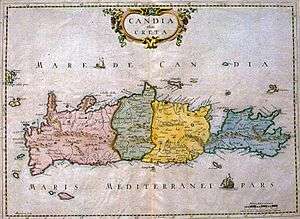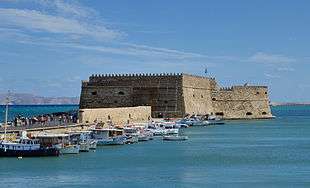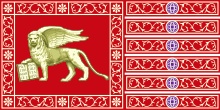Kingdom of Candia
| Kingdom of Candia | ||||||||||
| Regno di Candia | ||||||||||
| ||||||||||
|
| ||||||||||
 The Venetian sestieri of Crete in the 13th century: 1. Santi Apostoli (Holy Apostles), 2. San Marco (St Mark), 3. Santa Croce (Holy Cross), 4. Castello, 5. San Polo (St Paul), 6. Dorsoduro | ||||||||||
 | ||||||||||
| Capital | Candia | |||||||||
| Religion | Roman Catholicism (official) Greek Orthodoxy (popular) | |||||||||
| Government | Colony | |||||||||
| Duke of Candia | ||||||||||
| • | 1212–1216 | Giacomo Tiepolo (first) | ||||||||
| • | 1667 | Girolamo Battagia (last) | ||||||||
| Historical era | Middle Ages | |||||||||
| • | Dissolution of Byzantine Empire (Fourth Crusade) |
1204 | ||||||||
| • | Cession to Venice | 1205 | ||||||||
| • | Revolt of St. Titus | August 1363 – 1368 | ||||||||
| • | Ottoman conquest of Cyprus |
1571 | ||||||||
| • | Ottoman conquest of Crete |
1645–1669 1669 | ||||||||
| • | Ottoman conquest of remaining Cretan isles |
1715 | ||||||||
| Currency | Venetian coins | |||||||||
| ||||||||||
| Today part of | | |||||||||
The Kingdom of Candia (Italian: Regno di Candia) or Duchy of Candia (Italian: Ducato di Candia) was the official name of Crete during the island's period as an overseas colony of the Republic of Venice, from the initial Venetian conquest in 1205–1212 to its fall to the Ottoman Empire during the Cretan War (1645–1669). The island was at the time and up to the early modern era commonly known as Candia after its capital, Candia or Chandax (modern Heraklion). In modern Greek historiography, the period is known as the Venetocracy (Greek: Βενετοκρατία, Venetokratia or Ενετοκρατία, Enetokratia).
The island of Crete had formed part of the Byzantine Empire until 1204, when the Fourth Crusade dissolved the empire and divided its territories amongst the crusader leaders (see Frankokratia). Crete was initially allotted to Boniface of Montferrat, but, unable to enforce his control over the island, he soon sold his rights to Venice. Venetian troops first occupied the island in 1205, but it took until 1212 for it to be secured, especially against the opposition of Venice's rival Genoa. Thereafter, the new colony took shape: the island was divided into six provinces (sestieri) named after the divisions of the city of Venice itself, while the capital Candia was directly subjected to the Commune Veneciarum. The islands of Tinos and Cythera, also under Venetian control, came under the kingdom's purview. In the early 14th century, this division was replaced by four provinces, almost identical to the four modern prefectures.
During the first two centuries of Venetian rule, revolts by the native Orthodox Greek population against the Roman Catholic Venetians were frequent, often supported by the Empire of Nicaea. Fourteen revolts are counted between 1207 and the last major uprising, the Revolt of St. Titus in the 1360s, which united the Greeks and the Venetian coloni against the financial exactions of the metropolis. Thereafter, and despite occasional revolts and Turkish raids, the island largely prospered, and Venetian rule opened up a window into the ongoing Italian Renaissance. As a consequence, an artistic and literary revival unparalleled elsewhere in the Greek world took place: the Cretan School of painting, which culminated in the works of El Greco, united Italian and Byzantine forms, and a widespread literature using the local idiom emerged, culminating with the early 17th-century romances Erotokritos and Erophile.
After the Ottoman conquest of Cyprus in 1571, Crete was Venice's last major overseas possession. The Republic's relative military weakness, coupled with the island's wealth and its strategic location controlling the waterways of the Eastern Mediterranean attracted the attention of the Ottoman Empire. In the long and devastating Cretan War (1645–1669), the two states fought over the possession of Crete: the Ottomans quickly overran most of the island, but failed to take Candia, which held out, aided by Venetian naval superiority and Ottoman distractions elsewhere, until 1669. Only the three island fortresses of Souda, Gramvousa and Spinalonga remained in Venetian hands. Attempts to recover Candia during the Morean War failed, and these last Venetian outposts were finally taken by the Turks in 1715, during the last Ottoman–Venetian War.
Venetian conquest

Venice had a long history of trade contact with Crete; the island was one of the numerous cities and islands throughout Greece where the Venetians had enjoyed tax-exempted trade by virtue of repeated imperial chrysobulls, beginning in 1147 (and in turn codifying a practice dating to ca. 1130) and confirmed as recently as 1198 in a treaty with Alexios III Angelos.[1] These same locations were largely allocated to the Republic in the partition of the Byzantine Empire that followed the capture of Constantinople by the Fourth Crusade, in April 1204: in addition to the Ionian Islands, the Saronic Gulf islands and the Cyclades, she obtained several coastal outposts on the Greek mainland of interest as bases for her maritime commerce. Finally, on 12 August 1204, the Venetians preempted their traditional rivals, the Genoese, to acquire Crete from Boniface of Montferrat. Boniface had allegedly been promised the island by Alexios IV Angelos, but as he had little use for it, he sold it in exchange for 1,000 silver marks, an annual portion of the island's revenues totalling 10,000 hyperpyra, and the promise of Venetian support for his acquisition of the Kingdom of Thessalonica. Venice's gains were formalized in the Partitio Romaniae a few weeks later.[2]
To enforce their claim, the Venetians landed a small force in Spinalonga. The Genoese however, who already had a colony on Crete, moved quicker: under the command of Enrico Pescatore, Count of Malta, and enjoying the support of the local populace, they soon became masters over the eastern and central portions of the island. A first Venetian attack in summer 1207 was beaten off, and for the next two years, Pescatore ruled the entire island with the exception of a few isolated Venetian garrisons. Pescatore even appealed to the Pope, and attempted to have himself confiurmed as the island's king. It took the Venetians another five years of bloody warfare to force him to surrender; and only in 1218 did the war with Genoa end in a treaty that left Crete securely in Venetian hands.[3] Giacomo Tiepolo became the first governor of the new colony, with the title of "duke of Crete" (duca di Candia), based in Candia (modern Heraklion).[4] The duke usually held office for two years, assisted by two deputies and two councils.[5] Venetians used Crete as a center for their profitable eastern trade. Furthermore, they established a feudal state and administered a strict capitalist system for exploiting the island's agricultural produce. Exported products consisted primarily of wheat and sweet wine (malmsey), and to a lesser extend of timber and cheese.[6]

Venetian rule over Crete proved troubled from the beginning, as it encountered the hostility of the local populace. In the words of the medievalist Kenneth Setton, it required "an unceasing vigilance and a large investment in men and money to hold on to the island".[7] Although the local Greeks, both the noble families and the wider populace, were allowed to keep their own law and property, they resented Latin rule and the strict discrimination between them and the Latin Venetian elite, which monopolized the higher administrative and military posts of the island and reaped most of the benefits of the commerce passing through it. During the early period of Venetian rule, the Venetian colonists consciously maintained themselves apart; until the end of the 13th century, even mixed marriages between native Cretans and Venetians were prohibited.[8]
Already in 1212, the Hagiostephanitai brothers rose in revolt, which was only suppressed through the intervention of Marco I Sanudo, the Duke of Naxos. Sanudo then attempted to conquer the island for himself, relying on local support. He seized Candia, while Tiepolo escaped to the nearby fortress of Temenos disguised as a woman. The arrival of a Venetian fleet allowed Tiepolo to recover the capital, and Sanudo agreed to evacuate the island in exchange for money and provisions; the Greek lords who had collaborated with him accompanied him to Naxos.[9] Subsequently, the Cretans looked to the Greek Empire of Nicaea for aid in 1229, when a new rebellion broke out on the island. A Nicaean fleet arrived on the island, and in the 1230s the Nicaeans were able to challenge Venetian control over much of Crete and maintain troops there. It was only with the aid of the Greek lord of Rhodes, Leo Gabalas, that the Venetians were able to force their withdrawal in 1236.[10] Venetian rule over Crete was finally and formally recognised by the restored Byzantine Empire in treaties concluded in 1268 and 1277.[11]
References
- ↑ Miller, p. 5; Nicol (1992), pp. 81, 85-86
- ↑ Miller, pp. 28-29; Nicol (1992), pp. 149-150; Setton (1976), pp. 16-18
- ↑ Miller, pp. 47-48; Nicol (1992), p. 158
- ↑ Miller, p. 48; Nicol (1992), p. 164
- ↑ Setton (1976), p. 178
- ↑ Stallsmith (2007)
- ↑ Setton (1976), pp. 177-178
- ↑ Setton (1976), p. 178
- ↑ Miller, pp. 571-572
- ↑ Miller, pp. 574-575; Nicol (1992), pp. 171-172
- ↑ Nicol (1992), pp. 191, 198
Sources
| Wikimedia Commons has media related to Crete under Venetian Rule. |
- Abulafia, David: Enrico conte di Malta e la sua Vita nel Mediterraneo: 1203-1230, in In Italia, Sicilia e nel Mediterraneo: 1100-1400, 1987.
- Lane, Frederic C. (1973), Venice, A Maritime Republic, Johns Hopkins University Press, ISBN 978-0801814600
- McKee, Sally (2000), Uncommon Dominion: Venetian Crete And The Myth Of Ethnic Purity, University Of Pennsylvania Press, ISBN 978-0-8122-3562-3
- Miller, William (1908), The Latins in the Levant, a History of Frankish Greece (1204–1566), New York: E.P. Dutton and Company
- Nicol, Donald M. (1992), Byzantium and Venice: A Study in Diplomatic and Cultural Relations, Cambridge University Press, ISBN 978-0-521-42894-1
- Papadopoli, Zuanne (2007), L'occio (time of leisure). Memories of seventeenth century Crete; preface & comments by Alfred Vincent, Venice: Hellenic Institute of Byzantine studies in Venice, ISBN 978-9-60774-341-1
- Setton, Kenneth M. (1976), The Papacy and the Levant, 1204–1571: Volume I, The Thirteenth and Fourteenth Centuries, DIANE Publishing, ISBN 978-0-87169-114-9
- Stallsmith, Allaire B. (2007), "One Colony, Two Mother Cities: Cretan Agriculture under Venetian and Ottoman Rule", in Davies, Siriol, Between Venice and Istanbul: Colonial Landscapes in Early Modern Greece, Hesperia Supplements, 40, The American School of Classical Studies at Athens, pp. 151–171, ISBN 9780876615409
External links
Coordinates: 35°19′N 25°08′E / 35.317°N 25.133°E



